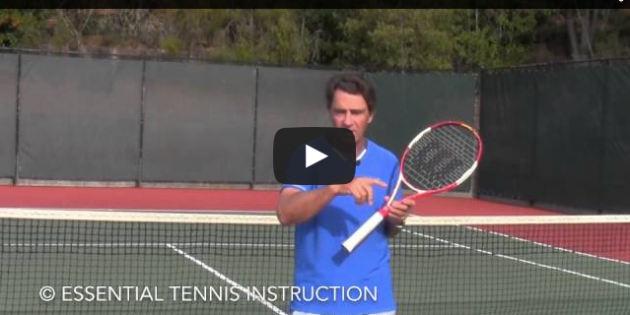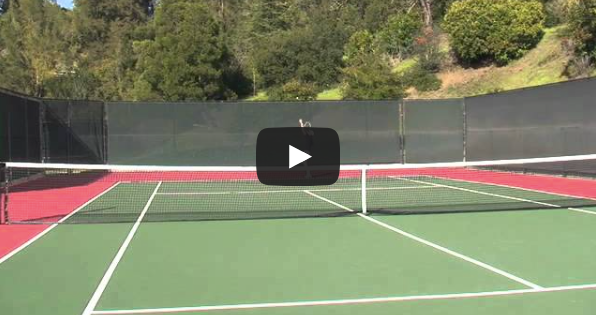ETI 033 | Throwing vs. the Pendulum
Consider the elements in a strong and fluid overhand throw – and how the actions of the hand and elbow can be used or even copied in the modern forehand as well as certainly the serve.
Once when racquets were heavy and wooden, we could see (and still see now and then) a type of pendulum swing – back and forth with little whip or acceleration. Interestingly McEnroe still uses such a forehand to truly devastating effect.
ETI 032 | Attitude – the Space between Stimulus and Response
An excellent book, Man”s Search for Meaning, written by Victor Frankl, serves as a useful guidepost in living but equally when playing on court.
When Andy Murray hooked up with Ivan Lendl to capture his two grand slam titles, he was working at the same time with a sports psychologist (the same one who had worked with Lendl years before) to improve his attitude – to improve his emotional responses to the challenges he faced (and still faces) on court.
ETI 031 | Building Self Confidence
One of Northern California’s legendary teachers, as well as a dear friend and mentor to me, Fred Earle penned the following 5 keys – that he expected his players to answer with a resounding yes, each and every day at the end of practice or a game.
ETI 030 | Forward Spin
Squaring up – Hitting the ball true – precise contact on the back of the ball.
We all know about topspin – but have you ever tried to strike the ball with true topspin – where the ball rolls forward – precisely forward?
The following drop hit drill will improve your time spent practicing on court – and help you with your forehand and or your backhand.
ETI 029 | Tap Tap Tap
Balance, holding your finish, placing your weight precisely against the ball.
Yes there are many ways to hit the ball, and many ways to play this game, but with all the variety of styles and technique – our best professionals are balanced more often than perhaps we readily notice.
ETI 028 | Scan and Zoom
Is there more to it than simply watching the ball?
Well, the answer is yes. But the answer is not readily apparent.
Scan and zoom describes two different visual orientations, both of which occur on court.
In your own game, are you better at scanning or zooming? Better yet, are you skilled at both?
McEnroe, Courier and Sampras

Power Shares Champions Shootout. Great event. Let me repeat – great event. The format is brief, two one set semifinal singles followed by a one set final between the two semi winners. In this case Mac played Courier, Sampras played Blake – and then in the final the younger man beat the oldest man…
ETI 027 | The 3R’s of Tennis
Ready Read React – the all important “3 R’s” of tennis.
But the question, once you have been ready and now have read the incoming direction of the ball – how do you react? What is your first move?
The first move is about quickness, it is about simplicity, but equally if not more importantly, it is about committing and reacting to only and simply what you have read.
If you want to be quicker and find more time to hit the ball – improve your first move.
5 Keys to Playing (and competing against) the Pusher

Every club has one of these, a player who moves very well, makes darn few errors, often hits the ball softly or with unusual form, but over and over again this is a player who wins, and more than that this is a player that most dread. The term “pusher” is somehow derogatory, implying that…
ETI 026 | Loose Strings – Very Loose Strings
The game has changed from the old wooden racquet era. Next was graphite composite racquets. Then stronger and stronger players. Followed by more and more topspin (unfortunately from further and further behind the baseline).
The next era in our game’s development occurs from the new “copoly” strings – essentially a polymer material, but somehow little or no friction between the strings.
You will note, no longer do the players walk around between points straightening their strings. That is because those strings move back and forth when meeting the ball – imparting much much more spin.
ETI 025 | Drop Shot – playing North to South
Play the ball to the open court. Run your opponent. Hit it where they “ain’t” (sorry).
Too often we focus on moving the ball east and west, meaning from side to side. Another option, in some instances a better option, is to play the ball deep and short, very deep and very short. Think of this as moving the ball north and south.
Drop shots will do the trick. Backspin, finesse, stroking from high to low with an open racquet face. But, and this is most important, always meet this ball on the rise, from inside the baseline.
ETI 024 | Split Step – Be Quick
Three R’s – ready read and then react.
Ready – feet spread, knees softly bent, weight on the balls of the feet
Read – as quickly as possible read the ball, see clearly is this ball coming to the forehand or backhand side
React – turn your shoulders and hips to the ball as quickly as possible.
Returning the Kicker

We have positioned the camera at eye level, on the baseline, as though returning serve in the ad court. I nearly hit Antony on one of these serves, but no worries Mate, he is an Aussie. That said I think this camera angle gives you the feel for how this serve jumps up and away…
ETI 023 | Borrowing Pace – Tennis Ju-jitsu
Tennis ju-jitsu. Blocking, borrowing, deflecting the ball, playing with angles and change of pace.
The game is not always about power and winners. Just as easily the game can become one of rebounding the ball, using the opponent’s force and incoming shot to create our own.
This style, ju-jitsu if you will, comes from shorter strokes, firmer grips at contact, and a willingness to look for angles, dinks, drops and more.
McEnroe was the unquestioned master of this – try it out for yourself.
ETI 022 | Relish the Contest
Relishing the contest. Appreciating the opponent. Understanding (really) the rules of a contest.
To my mind, some matches are determined before ever hitting the first ball. We have all been in situations where we knew immediately that the opponent had no chance – and equally we have all been in situations where we knew immediately that we had no chance. None at all.
The fun occurs, when we play an evenly matched opponent. And in these contest, both players have an even chance to win.
Look for these opportunities. Keep your cool. You can be ahead and blow this lead, you can play from behind and catch up – but in any event there is chance, there is luck, there are a few balls close to the line.
The Tradition Continues – Segura – Connors – Djokovic
Novak Djokovic captured his third consecutive Australian Open title. Crushing David Ferrer 62 62 61 in the semifinals, and wearing down and then beating back the challenge of Andy Murray 67 76 63 62. The end the fourth set of the men’s final showcased a dominant and domineering Novak Djokovic and a dispirited but…
Andy Murray’s New Attitude – you read it here first
Ours is a wonderful, but equally ours is a very difficult game. We have all had days when we played great, sometimes unexpectedly great. And we have all had days when we played far far below our best level, said another way far below our expectations. When some say the game is 95% mental, I…
ETI 021 | Deep and Up the Middle
Time and Angle. Tactics – plain and simple.
If you move the opponent well behind the baseline – you will have more time to respond, and their angle of play becomes smaller.
If that opponent is as deep but in one corner or the other, their angle remains the same but their cross court shot will cross the sideline at a steeper angle.
The famous Jack Kramer was known to play the ball deep and up the middle, whenever he had not gained control of the point with his serve or volley.
The same will work for you.
ETI 020 | Power Lines
Ours is a game of managing errors, of keeping the ball in play, and with each and every shot always playing the percentages.
Play the ball close to the line, you encounter the risk of an error. Play the ball close to the line when the opponent is out of position, now the reward may outweigh the risk.
But worse, sometimes it is possible to lose points simply because you are never truly taking any risks.
With this in mind, consider the line of the incoming ball, and whether you return the ball back along that same line – and this play will always minimize errors. You are playing essentially as a wall. But if you change the line, such that you take a cross court and return if up the line, or you take an up the line and return it cross court – in those instances you are changing the line of play.
If the opponent hits the ball much harder (setting up a power line) then your decisions become much more important, said another way certain decisions expose you to much more risk.
I recommend always play back along incoming cross court power lines – minimize risk, let them change the line.
ETI 019 | Fire the Extensors
Many elements are combined to produce the serve – and one of the secrets is to have all the elements firing in the appropriate sequence.
Timing – we have all felt the effortless hits and unfortunately we all have at one time or another, felt the effortful hits.
One of the most important sequence during the serve occurs with regard to the racquet drop and the knee bend.
In general, on the serve, one must fire in quick sequence large muscles first leading to smaller and then smaller muscles, culminating in a whip at the top of the swing.
As regards the racquet drop and knee bend, the best one I heard on this was from Vic Braden, who said, “Fire the extensors baby!”
ETI 018 | The Heavy Ball
One of the most common phrases in tennis today is ‘hit a heavy ball’. So what is a heavy ball?
The incoming shot “feels heavy” when that shot has a lot of momentum.
Generally heavy shots are produced with a combination of racquet speed as well as body weight “against the ball.”
ETI 017 | Moving to the Ball – Turn and Go
Tennis – moving and hitting – not really much more to it. Quicker players have an advantage, consistent power hitters have an advantage.
When it comes to improving the moving, the footwork, your getting to the ball and recovering back to center – there are many training methods to chose from. The first and most obvious choice concerns weight training, where stronger muscles may help you “explode” to the ball. Another variation includes actual dance and balance exercises, where the goal becomes moving with more grace and less effort.
ETI 016 | Positioning for the Hit – Moving in Twos
Hopefully you have seen and worked through the podcast entitled Weighting and Waiting.
And as a subtle review, baseball batters “wait” on the pitch with their “weight” back. Similarly, pitchers and quarterbacks start their throwing motion with their “weight” back.
ETI 015 | Lobbing along the line of your shadow
In addition to consistency, control, spin and power, much less trying to produce your best tennis when the chips are down, a large part of the game includes your precise awareness of the conditions – meaning the direction of the wind, as well as the location of the sun.
The next time you are on court with the sun high in the sky, but equally when it is at your back, take special notice of your shadow. As the sun moves through the sky the line or alignment of the shadow will change.
ETI 014 | Alignment – Swinging Up and or Down
Many ways to play this game, many ways to grip the racquet, and truly many ways to hit the ball.
Flat, topspin, slice, sidespin, under spin – just to name a few (if not them all).
We know to hit up on the ball for topspin, to swing slightly down on the ball for slice or under spin, and to swing more or less level for a flat hit. And one proviso, the ball will always leave the racquet with some amount of spin, it is impossible to hit the ball perfectly flat. But for our purposes, flat will mean a ball with relatively little spin.

Recent Comments